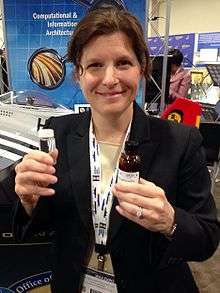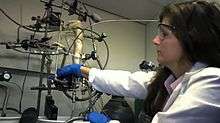Heather Willauer
| Heather Willauer | |
|---|---|
 Willauer shows samples of synthetic fuel | |
| Born | 1974 (age 41–42) |
| Residence | Fairfax Station, Virginia |
| Citizenship | United States |
| Fields | Analytical chemistry |
| Institutions | United States Naval Research Laboratory |
| Alma mater |
Berry College University of Alabama |
| Known for | Synthetic fuel from seawater |
Heather D. Willauer (born 1974) is an American analytical chemist and inventor working in Washington, D.C., at the United States Naval Research Laboratory (NRL). Leading a research team, Willauer has patented a method for removing carbon dioxide (CO2) from seawater, in tandem with hydrogen (H2) removed simultaneously. Willauer is researching catalysts to enable a continuous Fischer–Tropsch process to recombine carbon monoxide (CO) and hydrogen gases into complex hydrocarbon liquids to synthesize jet fuel for Navy and Marine aviation, and fuel for the U.S. Navy's ships at sea.
The work of Willauer's team of researchers, once the technology is incorporated into the U.S. Navy's warships in the 2020s, is expected to release such ships from their reliance on vulnerable replenishment oilers to give them indefinite time on station, if they are sailing in mildly acidic seawater. Especially significant is the ability to maintain naval air operations without regular deliveries of jet fuel. A side benefit of the technology is that it will decrease harmful ocean acidification, by removing CO2 from seawater.
Education
Willauer attended Berry College in Georgia, graduating with a bachelor's degree in chemistry in 1996.[1] In mid-1999 she participated in the 11th International Conference on Partitioning in Aqueous Two-Phase Systems, held in Gulf Shores, Alabama.[2] In 2002, she earned a doctorate in analytical chemistry from the University of Alabama, writing her thesis on "Fundamentals of phase behavior and solute partitioning in ABS and applications to the paper industry," the "ABS" an abbreviation for "aqueous biphasic systems".[3] She began working with the NRL as an associate, then in 2004 she advanced to the position of research chemist.[1]
Career
Willauer started researching biphasic systems and phase transitions after graduating from Berry College. In 1998 she studied aqueous biphasic systems (ABS) for the potential of recapturing valuable dyes from textile manufacturing effluent. She investigated ions and catalysts.[4]

In the 2000s, Willauer began researching methods for extracting CO2 and H2 from acidified seawater (seawater having a pH value below 6), for the purpose of recombining the molecules as hydrocarbon fuels.[5] She investigated modified iron (Fe) catalysts for dividing seawater into its component molecules, and she studied zeolite (nanoporous aluminosilicate) catalysts for recombining the molecules into fuel. Previous studies had concluded that CO2 was too stable to be economically removed from seawater, but by 2010 Willauer had discovered that an iron-based catalyst provided as much as a 50% conversion rate of available CO2 from seawater.[6] In January 2011, the NRL placed a prototype seawater processor at Naval Air Station Key West in Florida, while Willauer continued lab research in Washington.[7]
In 2012, Willauer estimated that jet fuel could be synthesized from seawater in quantities up to 100,000 US gal (380,000 L) per day, at a cost of three to six U.S. dollars per gallon.[8][9] As well, the Navy is interested in using the technology to power its ships.[10] In 2014, Willauer said that the catalyst could be changed to make various fuels such as methanol and natural gas, as well as the olefins that can be used as the building blocks for jet fuel. She said that about 23,000 US gal (87,000 L) of seawater must be driven through the process to result in one gallon of jet fuel. Seawater is the optimum choice because it contains 140 times more CO2 by volume than the atmosphere, and it yields usable amounts of H2 unlike the air. The equipment for processing seawater is much smaller than that for processing air. Willauer said seawater is the "best option" for a source of synthetic jet fuel.[11][12] By April 2014, Willauer's team had not yet made fuel to the standard required by military jets,[13][14] but they were able in September 2013 to use the fuel to fly a radio-controlled model airplane powered by a common two-stroke internal combustion engine.[7] Because the process requires a large input of electrical energy, a plausible first step of implementation would be for American nuclear-powered aircraft carriers (the Nimitz-class and the Gerald R. Ford-class) to manufacture their own jet fuel.[15] The U.S. Navy is expected to deploy the technology some time in the 2020s.[11]
Publications
Papers
- Jonathan G. Huddleston, Heather D. Willauer, Kathy R. Boaz, Robin D. Rogers (26 June 1998). "Separation and recovery of food coloring dyes using aqueous biphasic extraction chromatographic resins". Journal of Chromatography B. 711 (1–2): 237–244. doi:10.1016/S0378-4347(97)00662-2.
- Robin D. Rogers, Heather D. Willauer, Scott T. Griffin, Jonathan G. Huddleston (26 June 1998). "Partitioning of small organic molecules in aqueous biphasic systems". Journal of Chromatography B. 711 (1–2): 255–263. doi:10.1016/S0378-4347(97)00661-0.
- Heather D. Willauer, Jonathan G. Huddleston, Scott T. Griffin, and Robin D. Rogers (1999). "Partitioning of Aromatic Molecules in Aqueous Biphasic Solutions". Separation Science and Technology. 34 (6-7): 1069–1090. doi:10.1080/01496399908951081.
- Jonathan G. Huddleston, Heather D. Willauer, Robin D. Rogers (23 June 2000). "Solvatochromic studies in polyethylene glycol–salt aqueous biphasic systems". Journal of Chromatography B. 743 (1–2): 137–149. doi:10.1016/S0378-4347(00)00230-9.
- Mian Li, Heather D. Willauer, Jonathan G. Huddleston, and Robin D. Rogers (2001). "Temperature Effects on Polymer-based Aqueous Biphasic Extraction Technology in the Paper Pulping Process". Separation Science and Technology. 36 (5-6): 835–847. doi:10.1081/SS-100103623.
- Heather D. Willauer, Jonathan G. Huddleston, and Robin D. Rogers (May 2002). "Solvent Properties of Aqueous Biphasic Systems Composed of Polyethylene Glycol and Salt Characterized by the Free Energy of Transfer of a Methylene Group between the Phases and by a Linear Solvation Energy Relationship". Industrial & Engineering Chemistry Research. 41 (11): 2591–2601. doi:10.1021/ie0107800.
- Ann E. Visser, W. Matthew Reichert, Richard P. Swatloski, Heather D. Willauer, Jonathan G. Huddleston, Robin D. Rogers and the Department of Chemistry and Center for Green Manufacturing, the University of Alabama (July 2002). "23: Characterization of Hydrophilic and Hydrophobic Ionic Liquids: Alternatives to Volatile Organic Compounds for Liquid–Liquid Separations". Ionic Liquids. pp. 289–303. doi:10.1021/bk-2002-0818.ch023. ISBN 9780841237896.
- Heather D. Willauer, John Hoover, Frederick W. Williams, and George W. Mushrush (January 2004). "The Construction of an Improved Automated Atomizer for Evaluating Jet Fuel Flammability". Petroleum Science & Technology.
- George W. Mushrush, James H. Wynne, Heather D. Willauer, Christopher T. Lloyd, Janet M. Hughes and Erna J. Beal (2004). "Recycled Soybean Cooking Oils As Blending Stocks for Diesel Fuels". Industrial & Engineering Chemistry Research. 43 (16).
- Heather D. Willauer, Ramagopal Ananth, John B. Hoover, George W. Mushrush, Frederick W. Williams (November 2004). "A Critical Evaluation of An Automated Rotary Atomizer". Petroleum Science & Technology.
- George W. Mushrush, Heather D. Willauer, John Hoover, Jean Bailey, and Frederick W. Williams (January 2005). "Flammability and Petroleum Based Hydraulic Fluids". Petroleum Science & Technology.
- "Instability Reactions and Recycled Soybean Derived Biodiesel Fuel Liquids. George W. Mushrush, James H. Wynne, Christopher T. Lloyd, Heather Willauer, Janet M. Hughes". Energy Sources. January 2005.
- Heather D. Willauer, John B. Hoover, George W. Mushrush, and Frederick W. Williams (March 21, 2005). "Evaluation of Jet Fuel Aerosols Using a Rotary Atomizer". 4th Joint Meeting of the U.S. Sections of the Combustion Institute. Retrieved June 17, 2014.
- H.D. Willauer, D.R. Hardy, F. DiMascio, R.W. Dorner, and F.W. Williams (2010). "Synfuel from Seawater" (PDF). NRL Review. United States Naval Research Laboratory: 153–154.
- Ramagopal Ananth, Heather D. Willauer, John P. Farley and Frederick W. Williams (2012). "Effects of Fine Water Mist on a Confined Blast". Fire Technology. 48 (3): 641–675.
- Heather D. Willauer, Dennis R. Hardy, Kenneth R. Schultz and Frederick W. Williams (2012). "The feasibility and current estimated capital costs of producing jet fuel at sea using carbon dioxide and hydrogen". Journal of Renewable Sustainable Energy. 4 (033111). doi:10.1063/1.4719723.
Patents
- Extraction of Carbon Dioxide and Hydrogen From Seawater and Hydrocarbon Production Therefrom Filed: December 2, 2010. Granted: November 17, 2011.
- Recovery of CO from seawater/aqueous bicarbonate systems using a multi-layer gas permeable membrane Filed: June 25, 2009. Granted: November 20, 2012.
- Catalytic support for use in carbon dioxide hydrogenation reactions Filed: October 28, 2010. Granted: February 25, 2014.
- Method for the continuous recovery of carbon dioxide from acidified seawater Filed August 10, 2012. Granted March 4, 2014.
References
- 1 2 Larson, Don (June 16, 2013). "Opportunities in Nuclear – Second Annual Ohio State University Nuclear Power Forum, September 19, 2013". Energy from Thorium Foundation. Retrieved June 18, 2014.
- ↑ "List of Participants" (PDF). Gulf Shores, Alabama: 11th International Conference on Partitioning in Aqueous Two-Phase Systems. June 27 – July 2, 1999. Retrieved June 17, 2014.
- ↑ Willauer, Heather D. (2002). "Fundamentals of phase behavior and solute partitioning in ABS and applications to the paper industry". Tuscaloosa, Alabama: University of Alabama, Department of Chemistry.
- ↑ Jonathan G. Huddleston, Heather D. Willauer, Kathy R. Boaz, Robin D. Rogers (26 June 1998). "Separation and recovery of food coloring dyes using aqueous biphasic extraction chromatographic resins". Journal of Chromatography B. 711 (1–2): 237–244. doi:10.1016/S0378-4347(97)00662-2.
- ↑ Parry, Daniel (September 24, 2012). "Fueling the Fleet, Navy Looks to the Seas". Naval Research Laboratory News.
- ↑ H.D. Willauer, D.R. Hardy, F. DiMascio, R.W. Dorner, and F.W. Williams (2010). "Synfuel from Seawater" (PDF). NRL Review. United States Naval Research Laboratory: 153–154.
- 1 2 Parry, Daniel (April 7, 2014). "Scale Model WWII Craft Takes Flight With Fuel From the Sea Concept". Naval Research Laboratory News.
- ↑ Heather D. Willauer, Dennis R. Hardy, Kenneth R. Schultz and Frederick W. Williams (2012). "The feasibility and current estimated capital costs of producing jet fuel at sea using carbon dioxide and hydrogen". Journal of Renewable Sustainable Energy. 4 (033111). doi:10.1063/1.4719723.
- ↑ Szondy, David (September 26, 2012). "U.S. Navy looking at obtaining fuel from seawater". GizMag.
- ↑ Palmer, Roxanne (December 17, 2013). "How The Navy Might Spin Seawater Into Jet Fuel". International Business Times.
- 1 2 Tozer, Jessica L. (April 11, 2014). "Energy Independence: Creating Fuel from Seawater". Armed with Science. U.S. Department of Defense.
- ↑ Koren, Marina (December 13, 2013). "Guess What Could Fuel the Battleships of the Future?". National Journal.
- ↑ Tucker, Patrick (April 10, 2014). "The Navy Just Turned Seawater Into Jet Fuel". Defense One.
- ↑ Ernst, Douglas (April 10, 2014). "U.S. Navy to turn seawater into jet fuel". The Washington Times.
- ↑ Putic, George (May 21, 2014). "US Navy Lab Turns Seawater Into Fuel". VOA News.